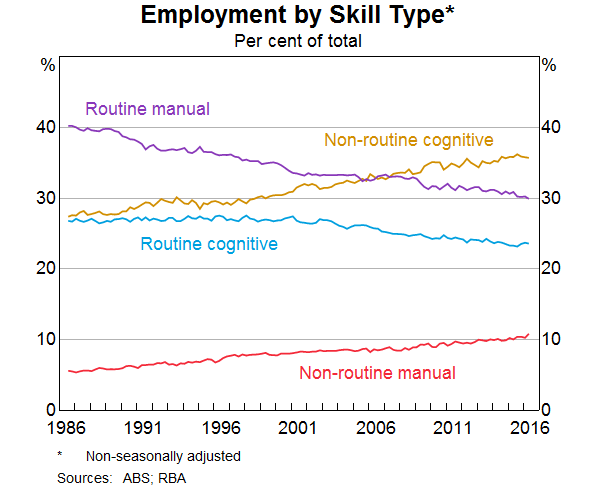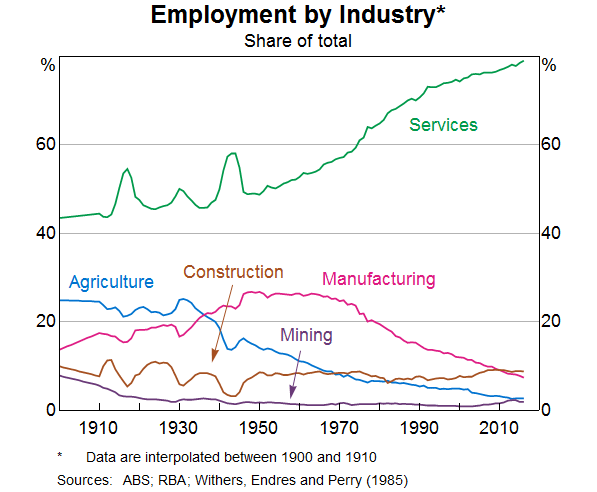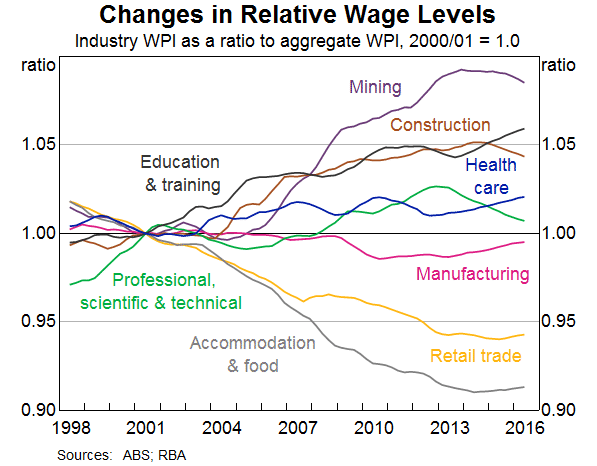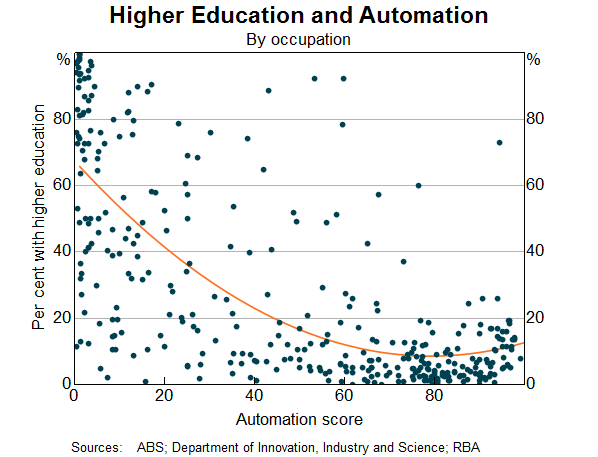Speech The Changing Nature of the Australian Workforce

Alexandra Heath
[*]
Head of Economic Analysis Department
CEDA – Future Skills: The Education and Training Pipeline
Brisbane –
The underlying policy question of CEDA's report on the vocational education and training sector is whether the education system has the ability to meet the changing demand for skills in the Australian workforce. This has a direct bearing on the wellbeing of Australian households through its effects on productivity growth and the unemployment rate. As such, this is an important issue for the Reserve Bank, which has the prosperity of the Australian people at the core of its mandate. The Bank also has a more personal interest in these issues because we are an employer facing the challenges of finding the right people with the right skills to meet our changing needs.
Today, I will address some of the ways the Australian workforce has been changing in response to forces such as demographic change, which tends to be slow-moving, and technological change, which can be quite abrupt. Then I will explore how individuals and organisations can equip themselves to adapt to these changes. Clearly the education system has a huge role to play here, and the CEDA report being launched today has much to say on this topic.
The Changing Nature of the Australian Workforce
There are many ways to classify the workforce to understand how it has changed over time. Recent research has tended to focus on whether jobs are cognitive or manual and how routine they are (Autor 2010). Over recent decades, there has been a noticeable decline in the share of people employed in routine manual jobs (Graph 1). Industries that have high shares of routine manual occupations include construction, mining and manufacturing.

A part of the explanation for this trend is that some of these jobs have been automated. Indeed, the decline in the share of routine manual jobs in industries such as agriculture and manufacturing as a result of technological change has had a long history (Graph 2). The offsetting increase has been in service sector jobs.

However, there has been a decline in the share of routine cognitive jobs since the early 2000s. One explanation for this is that the IT revolution of the 1960s and 1970s has exposed a new set of occupations to the possibility of automation. Technology has also made it possible for some routine cognitive jobs to be done in other parts of the world where labour costs are lower. Offshore call centres and back-office functions are examples of how technological change has facilitated the movement of jobs that were typically thought of as non-tradeable. Last year, CEDA found that many Australian occupations are ‘highly susceptible’ to automation and other research has shown that this trend is common across most advanced economies.[1]
In contrast, non-routine jobs have become steadily more important. These jobs tend to be more difficult to automate for a number of reasons. For example, some non-routine occupations, such as architecture, may require creativity and the ability to solve non-routine problems, while others, such as child care work, intrinsically require a physical human presence. The Australian workforce may also have a comparative advantage in many occupations in the non-routine category because of our relatively high education levels.
The health care & social assistance industry has made the largest contribution to employment growth over the past 15 years or so, and most of this has been in non-routine work (Graph 3). After health care, the two industries that have made the largest contributions to growth in non-routine jobs over this period are professional, scientific & technical services and education & training.

Some of the increase in health care employment is related to the ageing of the population. Similar demographic trends are also likely to have contributed to the strong increase in employment in social assistance because it includes in-home support services. The stability of relative wages in the health sector over most of the past 15 years suggests that the expansion of demand for health care workers has been more or less met by an increase in the number of people who are able to work in the sector (Graph 4). As the CEDA report being launched today points out, the vocational education and training system has played an important role in providing qualifications in a range of these occupations, including child care, aged care and occupational therapy.

In contrast, education & training, construction and mining have all experienced a trend increase in their relative wages over the past 15 years or so. This suggests that the supply of workers with the right skills has not kept up with the increase in demand from these industries. In the case of mining and construction, the mining boom is an important part of the story (Kent 2016).
The relative wages for professional, scientific and technical services increased over the 5 years to 2013, but have since fallen. One possible explanation for this is that there was some difficulty meeting increasing demand and that supply of qualified workers responded with a lag. Another possibility is that rapid technological change has meant that some of the growth in employment in this industry has been in entirely new jobs that take some time to be captured in some wage measures.[2]
Research for the United States has shown that employment growth has been faster for occupations that have created more new job titles (Acemoglu and Restrepo 2016). A recent Productivity Commission report on digital disruption provides many examples of how fast a change in technology can precipitate changes to employment (Productivity Commission 2016). The Bank's liaison program suggests that the rate of technological change has made it hard to find enough people with the right technical skills and experience to fill jobs in some occupations. Examples include data analytics and IT security, which have also experienced consistently above-average wage growth. All these examples serve to emphasise the positive aspect of skill-biased technological change; although technological change makes some jobs redundant, history repeatedly demonstrates that others are created in their place.[3]
This raises the question of how the workforce can pre-empt and adapt to changes in demand for skills?
How does the Workforce Adapt to Changes in Demand for Skills?
The answer will partly depend on the nature of the changes. Just as the natural environment generally adapts to gradual changes, the workforce also appears to be able to respond to relatively slow-moving and predictable changes in demand for skills, such as those associated with the ageing of the population. However, both the natural environment and the workforce have more difficulty adapting to rapid change.
What sorts of skills are needed, and how can they be acquired? The increase in the relative importance of non-routine jobs suggests that people will need skills that are not easily replicated by technology, such as social intelligence, creativity and complex manual dexterity (Frey and Osborne 2013). Additionally, learning how to learn, developing problem solving skills and having ‘core’ skills in maths or science will increase the ability of employees to keep technical skills current and adapt to changes in technology that are likely to be a feature of working life. Encouraging this sort of investment in human capital is also important at the macroeconomic level to make sure we sustain our high living standards (Lowe 2014).
The formal education system clearly has an important role to play. Analysis by the Department of Innovation, Industry and Science shows a strong negative relationship between a job's automation potential and the share of workers in that job with post-school qualifications (Edmonds and Bradley (2015), Graph 5). The challenge for the higher education and vocational training sectors is to provide opportunities to develop this broader set of transferable skills while fulfilling their traditional role of teaching technical skills. The recommendations in the CEDA report speak directly to these issues.

How does the Workplace Adapt?
Technological change is likely to have profound effects on how work is organised. Organisational structures may need to change to accommodate more flexible work practices and foster more collaborative and team-based styles of work. It seems likely that the ‘psychological contracts’ between employees and employers will increasingly focus on providing opportunities to develop competencies and expectations around work-life balance, rather than on life-long job security. The capacity of employers to provide more opportunities for employees to broaden, develop and update their skills will depend on their relationship with the education system and how this evolves. The CEDA report notes that the vocational education and training system has an important role to play and has already demonstrated its ability to adapt to changing needs.
There is also increasing awareness that an organisation's ability to adapt to changing circumstances is greatly enhanced by having diversity in its workforce. The benefits of diversity come from having employees who bring diversity of thought, diversity in their approaches to problem solving and diversity in their skills and experience. In our own organisation, there are numerous examples where important questions have been raised or new problems have been solved by people who have technical skills or experience we have not historically focused on in the recruitment process. Examples include economists with previous experience in IT project management or with strong mandarin skills.
Our challenge, and the challenge of every organisation, is to approach recruitment and staff development in a way that recognises the value of diversity. How do we overcome the natural biases we have that make it easier to work with people who operate just like us? How do we define merit in a way that ensures we genuinely value diversity? There is a growing literature exploring these questions that deserves careful consideration.[4] CEDA and other organisations have also been actively promoting discussions of these issues. The ability to recognise the value of diversity will be related to the ability of organisations to adapt to the largely unpredictable ways in which the Australian workforce will change. Policy discussions about how businesses and the education sector can work together to deliver these outcomes is another input, to which CEDA has made an important contribution with the recommendations in this report on the vocational education and training sector.
Endnotes
I would like to thank Cameron Dark, Joel Pillar, Tom Rohling and Alexandra Rush for their assistance with preparing this speech. [*]
CEDA estimated that 40 per cent of occupations were highly susceptible to automation and similar research by the Department of Industry, Innovation and Science found that 44 per cent of jobs were vulnerable to computerisation (Edmonds and Bradley 2015). However, the OECD, using a different technique that emphasises tasks within jobs, found that only 9 per cent of existing jobs are automatable (Arntz, Gregory and Zierahn 2016). [1]
Graph 4 uses the Wage Price Index, which measures wage changes for a fixed set of jobs and is not affected by changes in quality and quantity of work. As such, this measure will only capture wage changes for new jobs with a considerable lag. [2]
There is an important parallel discussion about how profound technological change is likely to be for productivity growth and the future prosperity of individuals. Some argue that we are in the midst of a fourth industrial revolution that will lead to a new wave of productivity growth (Brynjolfsson and McAfee 2014; Schwab 2015). Others argue that current technological changes are not going to be sufficient to deliver the sorts of productivity growth we saw in the 20th century, following technological advances such as the widespread availability of electricity and the internal combustion engine (Gordon 2016). [3]
For example, see Bourke (2015), Chief Executive Women (2016) [4]
Bibliography
Acemoglu D and P Restrepo (2016), ‘The Race Between Machine and Man: Implications of Technology for Growth, Factor Shares and Employment’, National Bureau of Economic Research working paper No 22252.
Arntz M, T Gregory and U Zierahn (2016), ‘The Risk of Automation for Jobs in OECD Countries: A Comparative Analysis’, OECD Social, Employment and Migration Working Papers No 189.
Autor D (2010), ‘The Polarization of Job Opportunities in the U.S. Labor Market’ The Hamilton Project and The Center for American Progress, April, pp. 1-40.
Bourke J (2016), Which Two Heads are Better than One? How Diverse Teams Make Breakthrough Ideas and Smarter Decisions, Australian Institute of Company Directors.
Brynjolfsson E and A McAfee (2014), The Second Machine Age: Work, Progress, and Prosperity in a Time of Brilliant Technologies, W.W. Norton and Company, New York.
CEDA (2015), Australia's Future Workforce?, June.
Chief Executive Women (2016), In The Eye Of The Beholder: Avoiding The Merit Trap, August.
Edmonds D and T Bradley, (2015), ‘Mechanical Boon: Will Automation Advance Australia?’, Department of Industry, Innovation and Science Research Paper 7/2015.
Gordon R (2016), The Rise and Fall of American Growth: The U.S. Standard of Living Since the Civil War, Princeton University Press.
Frey C and M Osborne (2013), ‘The Future of Employment: How Susceptible are Jobs to Computerisation?’, Oxford Martin Programme on Technology and Employment Working Paper.
Lowe P (2014), ‘Building on Strong Foundations’ Address to the Australian Business Economists Annual Dinner, Sydney, 25 November.
Productivity Commission (2016), ‘Digital Disruption: What do Governments Need to Do?’, Productivity Commission Research Paper, June.
Schwab K (2015), ‘The Fourth Industrial Revolution: What it Means and How to Respond’, Foreign Affairs, December 12.